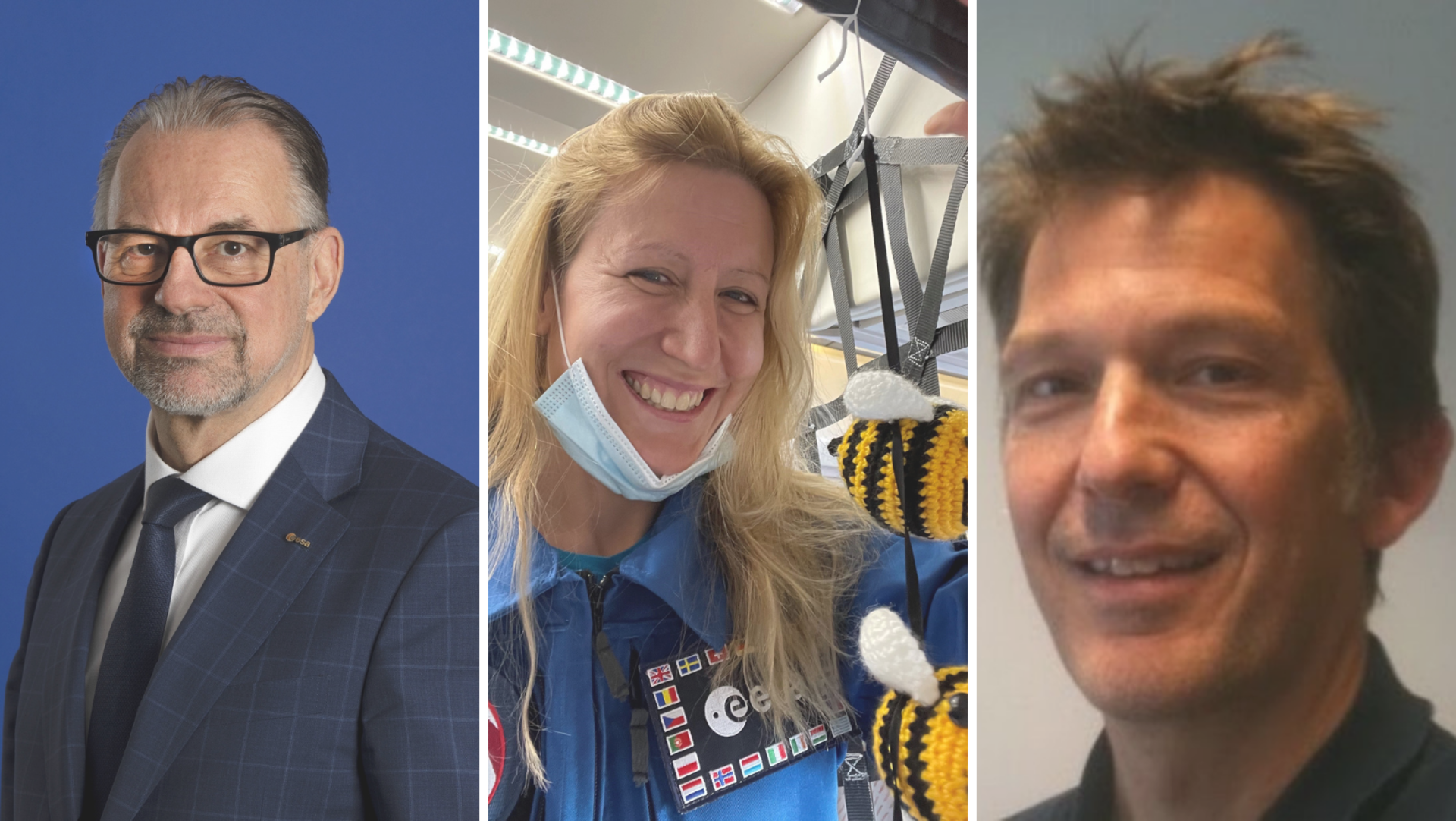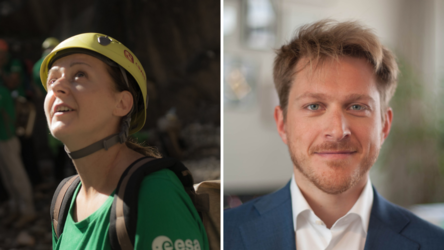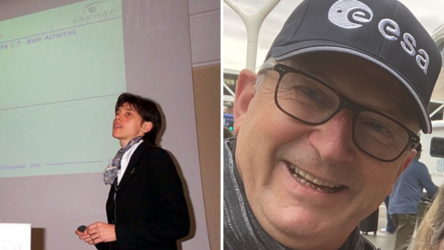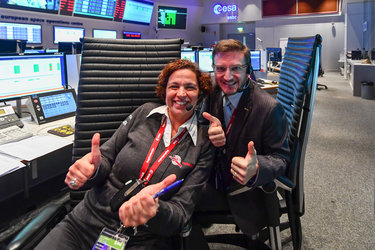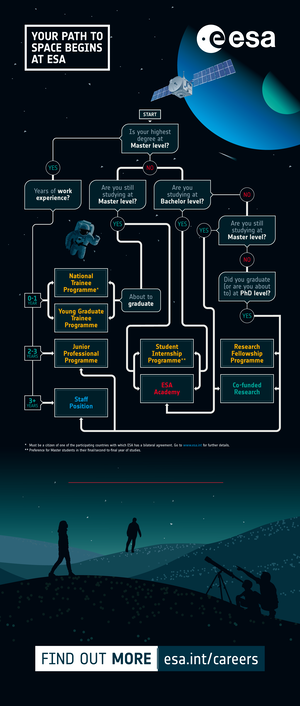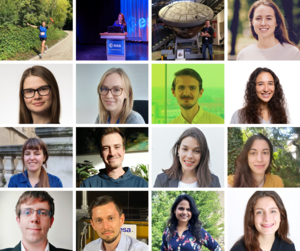YGTs – Where are they now?
Ever wondered where ESA’s former Young Graduate Trainees are today? The YGT Programme at ESA was launched in 1983, with the first ever YGTs starting their traineeships in 1984, and it has proven to be a hugely successful launch pad for young professionals looking for careers in the space industry. Of the current ESA staff, approximately 12% of employees are former YGTs. We have brought together several YGT alumni to talk about their career paths leading up to, during and after their YGT experience. Among the alumni we spoke to are Director General Josef Aschbacher and one of ESA’s very first YGTs. Read on to find out where alumni of the YGT Programme are today and stay tuned for the next publications!

The Young Graduate Trainee Programme has been a key stepping stone for entering the space professional environment and many former YGTs have continued their career with ESA, including myself! I’m excited to kick off this interview series which will continue with a number of our YGT alumni who were happy to share their own journeys as YGTs and beyond.
I began my career in ESA in 1990 as a Young Graduate at ESRIN, our establishment in Frascati, Italy. There I used digital image processing systems to analyse data from Landsat and simulated ones from ERS-1 in domains like land cover change or snow water equivalent.
With my educational background, Master and PhD in natural sciences, meteorology and geophysics, this YGT was, without a doubt, the start of a path to wonderful career opportunities in space. Beyond allowing me to gain professional experience it also helped me to get acquainted with the setting of an international organisation. And it has led to more than 30 years’ work experience at ESA, the European Commission, the Austrian Space Agency, the Asian Institute of Technology and the University of Innsbruck, culminating in my appointment as ESA Director of Earth Observation Programmes in 2016 and then as ESA DG in 2021.
That’s where the ESA YGT Programme brought me!
Let me now put my career back in the context of our well-established and well-known Young Graduate Traineeship Programme. Since the first round of YGTs joined ESA in 1984, the programme has provided approximately 2500 freshly graduated young Master’s students from ESA Member and Cooperating States with their first hands-on professional experience to kick off their careers.
The YGT Programme has evolved over the last four decades to meet the needs of ESA and of the European space industry, but its constant has been to offer a rich professional and personal experience of living and working abroad, an adventure that contributes to individuals’ personal growth and career development.
What I have seen over the years, and experienced myself, is that the YGT Programme fosters knowledge sharing, not only among other YGTs and young professionals but also with experienced experts. The programme is about mixing generations to add value both to the YGTs and the Agency as a whole. This mix of junior and senior level colleagues with different backgrounds, whether cultural, educational, or technical, leads to a unique mutual enrichment. I strongly believe in the force of our young graduates; in the part they play for the future for ESA and the European space sector.
As a former YGT, I find the incoming space generation very inspiring and believe that you all have what it takes to help us reach our European ambitions together. The YGT Programme helps the Agency move towards a more diverse and dynamic future. Through programmes like these, we are leading the space community to become more inclusive on many different fronts.
I strongly encourage all who qualify to apply to become an ESA YGT and to be a part of this fantastic learning experience. Your career path can get a kick-start with ESA and this can lead you in so many different directions.
ESA Payload Systems Engineer - Nadine Michaela Boersma

Current main project(s): Project Manager for The Internal Dosimetry Array (IDA) and the European Sensor Array (ERSA), the first two ESA payloads to be launched with the Moon orbiting Gateway station.
Years as a YGT: 2005-2006
What was your background/experience before becoming a YGT?
Before my Young Graduate Traineeship at ESA I graduated as Computer Engineer (Informatikerin), specialising in Robotics from the University of Karlsruhe, Germany.
Why did you apply to become a YGT?
I was a huge Star Trek and Science Fiction fan in my childhood and I promised myself I would be a “science officer” or whatever would come closest to that. When I saw the YGT opportunities I just had to apply, figuring there is nothing closer than working for ESA to make my oldest dream come true.
What did you work on as a YGT?
I worked in the Life and Physical Sciences Section of the Directorate of Technology, Engineering and Quality, where my YGT task was to develop a virtual maze (in virtual reality to be potentially used in neuroscience experiments on the ISS).
In addition, I got the chance to “jump on board” the Foton-M3 project, a Russian satellite incorporating 37 different scientific experiments. Not only did I get the opportunity to learn first-hand about real payload development of one of those experiment payloads, but I also supported the integration and launch preparations in Russia as well as the payload operations in Sweden after my YGT placement.
What is your most memorable or challenging moment as a YGT?
I remember my Section Head asking me on the second day to review a technical design description of a centrifuge and to confirm that the braking system was correctly sized. I didn’t have much idea about braking systems or centrifuges or anything remotely connected to this, but I dug out my formula collection and followed the report and calculations. Years later my Section Head admitted he was mainly impressed that I actually jumped in the cold water and bit my way through it. This was when he started to see me as part of his section that I would go on to work with after my YGT experience.
I remember feeling totally overwhelmed, but I also remember the pride I felt. I was happy that I was able to contribute to the nominal section work and that I had the opportunity to learn and discuss not only with my colleagues but also with my Section Head.
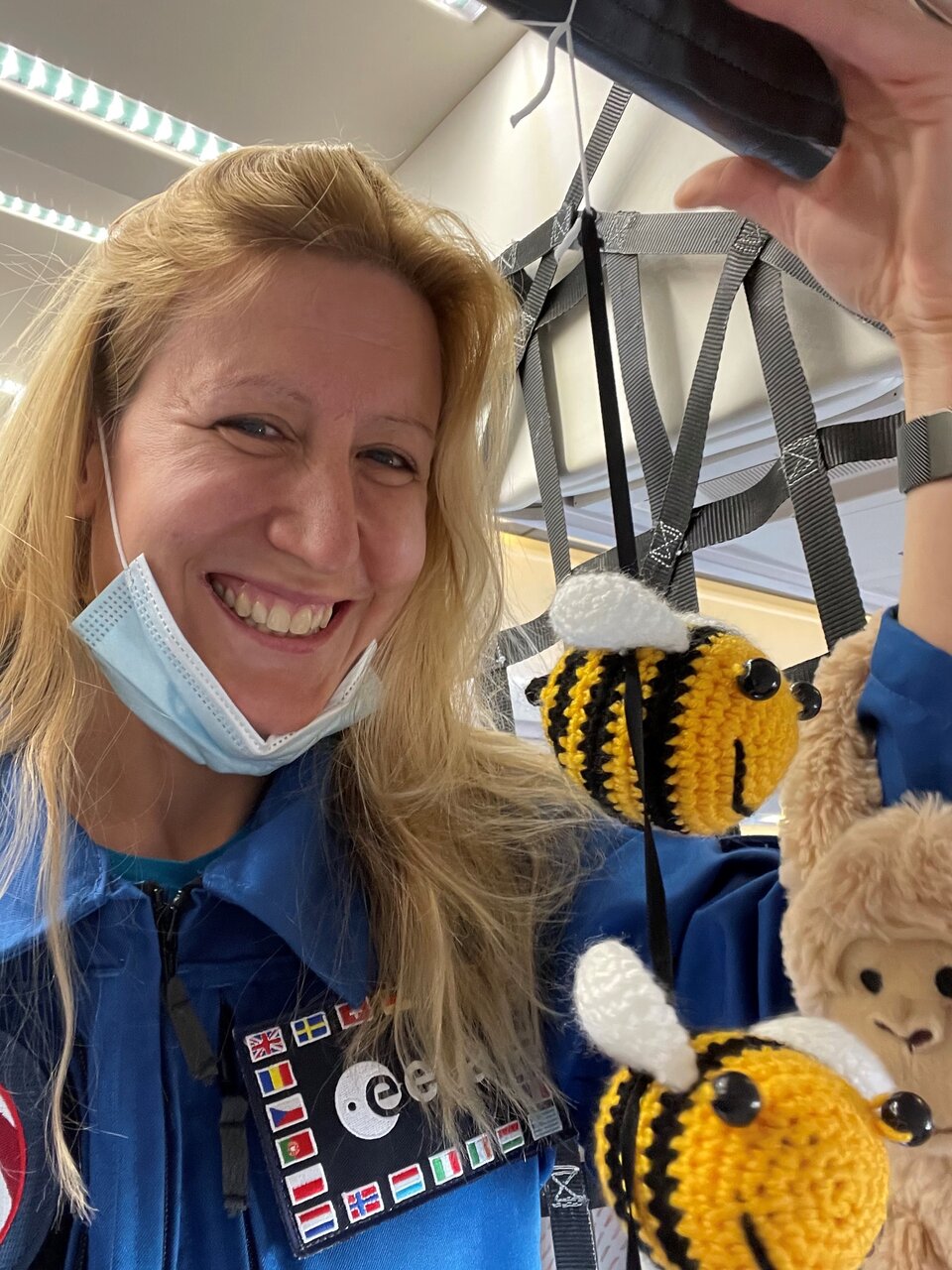
Where did your path lead to after your YGT experience?
I was very lucky to get a staff position in the section I was working in as a YGT and to continue working on the amazing Foton-M3 project, especially the Eristo payload, for which I became the System Engineer.
I continued working in the Directorate of Technology, Engineering and Quality for a few enjoyable years before joining Human Spaceflight. There I continued as Technical Officer (project manager) for several ISS projects before starting in the exciting field of developing flight payloads and complete payload packages for the new arising Gateway and Moon area.
How did the YGT help you in your future career?
Being a YGT was a fantastic experience. It gave me insight and training under a wonderful mentor. I learned the basics of system engineering and project management as well as international cooperation while also having the freedom to be creative in my own YGT tasks. Thanks to my YGT placement, in just one year I learned not only confidence but also the skills needed for the next, more independent, steps of my career.
What advice do you have for future YGT applicants?
Go for it. Don’t be shy, ask to be involved. Ask (if you want) to learn about not only what is on your YGT task, but also the real day-to-day work. Dare and risk to go beyond your comfort zone. And above all: enjoy! Both inside the office and outside it with all the other YGTs and international friends you will make.
As a last question, we asked the current YGTs to send us questions for the YGT alumni to answer that they believed would be valuable for applicants to hear about. The question picked by Nadine is:
What was the most valuable takeaway from the YGT programme?
After my studies I somewhat dreaded entering the working world (despite having had many side jobs), as all my preparation and knowledge felt dry and theoretical. In addition, the space world was overwhelming and new and very English. The YGT Programme made it easy to start working, giving me time to adjust and learn under the protected umbrella of a YGT Programme. The fact that many YGTs started at roughly the same time meant a lot of support, friends and fun. I felt as though barriers like language or culture became non-existent on day two or three and the overwhelming space world became an embracing opportunity and just a lot of fun. So, my most valuable take away from my time as a YGT is: a good work-life balance with friends for life and work you enjoy is totally possible and feels fantastic. I can only conclude saying that my YGT was a fantastic time and an experience I can still draw from every single day.
Head of the Mission Operations Definition Unit - Kim Nergaard

Current main project(s): European Large Logistics Lander (EL3), Sample Fetch Rover (SFR), Operations definition phase support to future ESA missions
Years as a YGT: 1992-1993
What was your background/experience before becoming a YGT?
I did a Bachelor’s degree in Computer Science and a Master’s degree in Cybernetics at the University of Oslo, Norway. My Master’s thesis was on optimising the launch parameters for sounding rockets measuring Aurora at the Andøya Rocket Range. My fields of expertise were celestial mechanics, expert systems and modelling/simulation. I also attended a summer session at the International Space University in Toulouse, France.
Why did you apply to become a YGT?
My ambition was always to enter the space sector and work on future missions to Earth orbit and beyond. While doing my Master’s thesis I attended a course in space science at the Andøya Rocket Range in northern Norway, where I met the Norwegian delegate who suggested I apply to the YGT Programme. I thought I didn’t have a chance, but nonetheless I submitted my application. I am very pleased I did!
What did you work on as a YGT?
The task assigned to me as a Young Graduate Trainee was to create a generic software system for modelling the celestial mechanics and environment of satellites to be included in the spacecraft simulators for spacecraft to be operated at ESA/ESOC. I took software developed for the ERS-2 satellite simulator and modified it so it could be configured for most ESA missions. Some of the software might actually still be in use today!
What is your most memorable or challenging moment as a YGT?
I was fortunate to be given a task that would be used in real missions. My supervisor and the other members of the simulation team offered support, so I never felt left alone. I learned to work in a team under pressure, where the outputs had to perform properly. I worked closely with industry, and this experience was key for my future career.
Where did your path lead to after your YGT experience?
An opportunity to join the simulation section in ESA/ESOC arose while I was a YGT and I was fortunate enough to get the position. Initially, I continued the work I was doing, but very quickly I was given project responsibilities for larger projects – always supported by my past supervisor and line manager, of course. I later applied for and was offered a Section Head position in a different department, responsible for looking at how missions could/should be operated in the future.
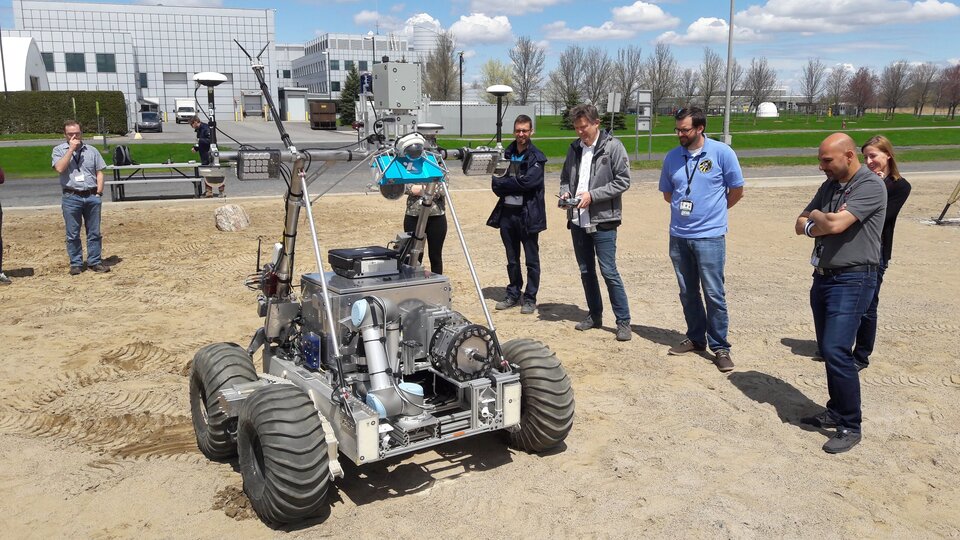
How did the YGT Programme help you in your future career?
The experience gained from being a YGT was instrumental in shaping my career. I learned how space missions work and how ESA functions as an international agency. Many of the friends and contacts I have today are people I got to know as a YGT.
One key element of my position at ESA has been to get inspiration from outside the Agency and one fantastic resource for us has always been Young Graduate Trainees. They bring fresh ideas and motivation and almost always provide valuable contributions to European space. So, not only did I benefit from being a YGT myself, but the YGT Programme is still adding value to my career by giving me access to the next generation of professionals that will continue the pursuit of European success in space.
What advice do you have for future YGT applicants?
The most important advice I have is – apply! I have spoken with so many students who wanted a career in space that didn’t think they had the “right stuff” for ESA. I thought that myself and was convinced I wouldn’t make it. I am very pleased I was proven wrong!
Most likely applying to the YGT Programme means you will spend some time away from your home town or even country. Think of that as an opportunity rather than a constraint.
Finally, don’t give up! I know people who didn’t make it the first time but applied again and were accepted.
As a last question, we asked the current YGTs to send us questions for the YGT alumni to answer that they believed would be valuable for applicants to hear about. The question picked by Kim is:
What are your thoughts on returning to ESA after gaining some industry experience?
Combining working for ESA with time in industry is very valuable. There are many career paths to follow but spending a year or two as a YGT and then going to industry is a very good approach, in my view. This is one thing I wish I had done as well. Those who have both ESA and industry experience understand both “sides”, something that is essential for a successful career in the European space sector.
YGTs – Where are they now series
This is the final part to a three-part interview series where we have asked YGT alumni about their experience during the YGTs. Enjoy reading part two and part three here if you missed them.
How do I apply for a YGT opportunity?
The YGT call for applications has closed as of 28 February 2022; however, we may need to republish some opportunities. Stay tuned and set up a job alert on the ESA job site here so that are notified as soon as any opportunities go live.
Learn more about the YGT Programme.


